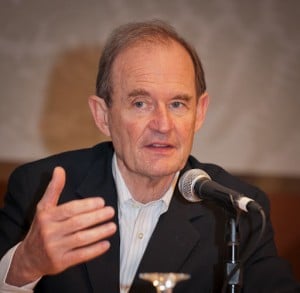Survey Indicates the Public Is Unconvinced That State Courts Need More Money

David Boies speaks at court funding panel Saturday.
Photo by Kathy Anderson
The American Bar Association and its allies, in their efforts to stem the tide of funding cuts that are sweeping over state courts across the country, face a serious challenge in crafting messages about the issue that will resonate effectively with the public, according to results of a survey that was conducted earlier this year.
The survey results were presented this afternoon at the ABA Annual Meeting and focused on the status of work by the association’s Task Force on Preservation of the Justice System, which is ending its official existence after two years of work on the court-funding crisis.
The issue will continue to be a priority for the ABA, however, and incoming President Laurel G. Bellows has announced that the association’s efforts in the area will be led by her two predecessors: Stephen N. Zack of Miami, who appointed the task force when he became president in August 2010; and Wm. T. (Bill) Robinson III of Florence, Ky., whose term ends at the close of the annual meeting on Tuesday.
The results of the survey of residents of Milwaukee, Phoenix and Richmond, Va., indicate that the public does not fully recognize the plight that state courts—and those who use those courts—are facing as a result of budget cuts imposed by legislatures, said Mike Bocian, a principal at Washington, D.C.-based GBA Strategies, which conducted the survey. The survey was commissioned by the National Center for State Courts and the Justice at Stake Campaign. The center estimates that 47 states have experienced funding reductions since 2010.
Only 13 percent of the survey respondents said they have great confidence in their state court systems, although 67 percent said they have some confidence in the courts, Bocian said. Just over half of the respondents said they believe their state courts are fair and impartial and provide equal justice for all. And only 17 percent of the respondents said they believe state courts are underfunded, placing them behind other state institutions like schools and law enforcement.
“The bones are showing in the budgets of the state courts,” Bocian said, “but most people don’t see that, and that’s the message we must give them.”
The survey results indicate, however, that not every message resonates with the public. Appeals based on arguments that the courts must remain an independent branch that is separate and co-equal with the executive and legislative branches, for instance, aren’t convincing to the public, Bocian said. He also cautioned against using case backlogs and the need for more staff as arguments for increased funding.
Instead, advocates of the courts should emphasize that the courts have been careful in how they use public funds, that delayed justice costs money for those who use the courts and that access to justice is vital to the public, Bocian said.
David Boies, one of the task force’s original co-chairs, acknowledged that public opinion about the courts won’t be changed overnight, and that the court-funding issue must be dealt with over the long term. “We didn’t get into this problem in two years, and we’re not going to get out of it in two years, but we have turned the corner,” said Boies, a partner in the Armonk, N.Y., office of Boies, Schiller & Flexner. The task force’s other original co-chair is Theodore B. Olson, a partner at Gibson, Dunn & Crutcher in Washington, D.C.
Boies also urged lawyers to continue to actively work for adequate funding for the state courts. “It’s remarkable how few lawyers are actually engaged in this effort,” he said. “We need lawyers to be energized. If lawyers aren’t going to defend the justice system, no one else will.”



